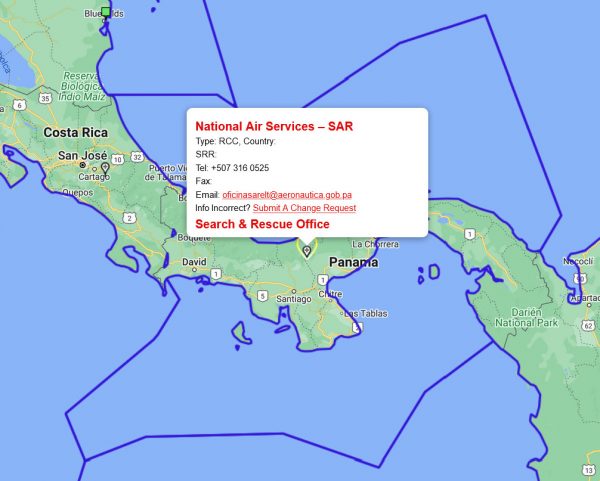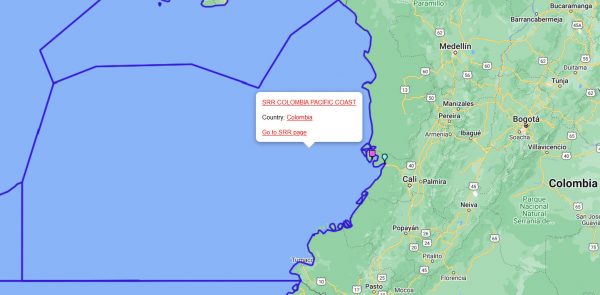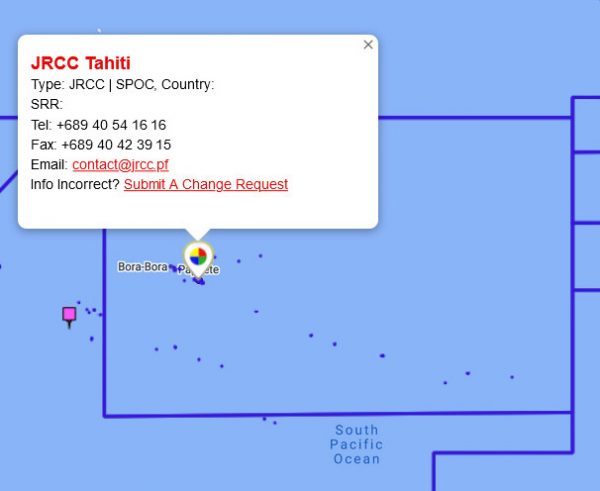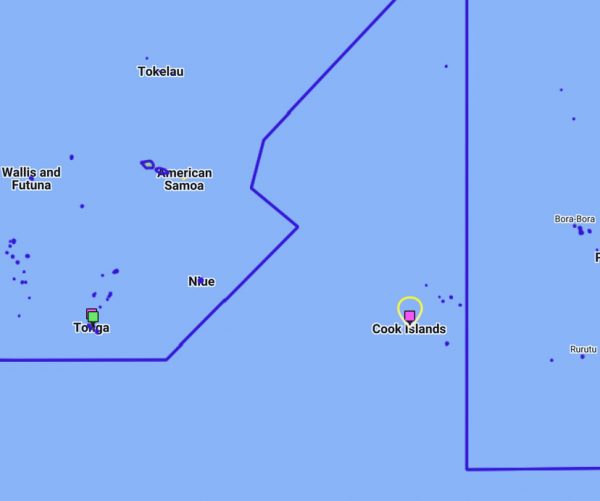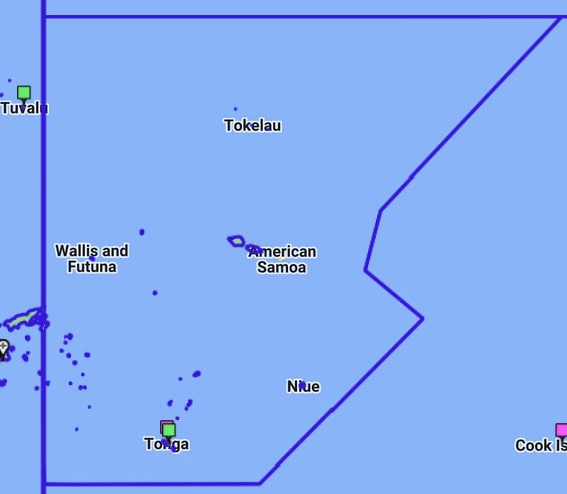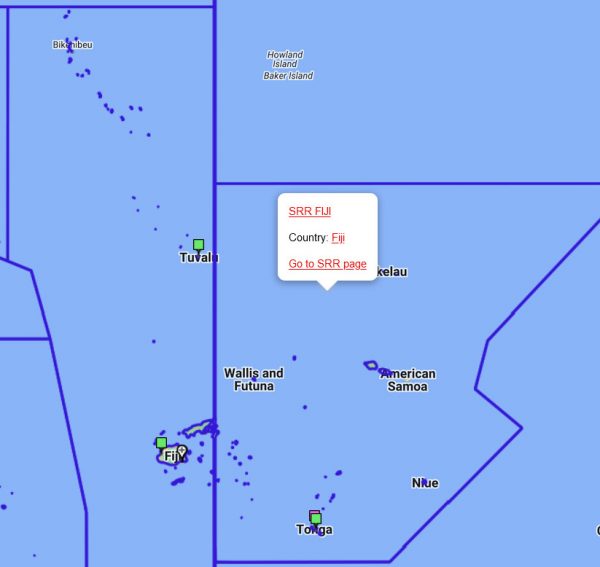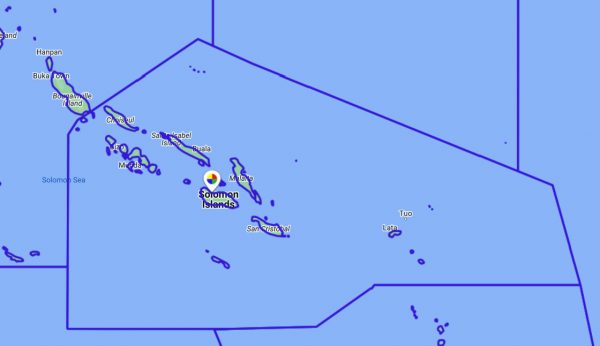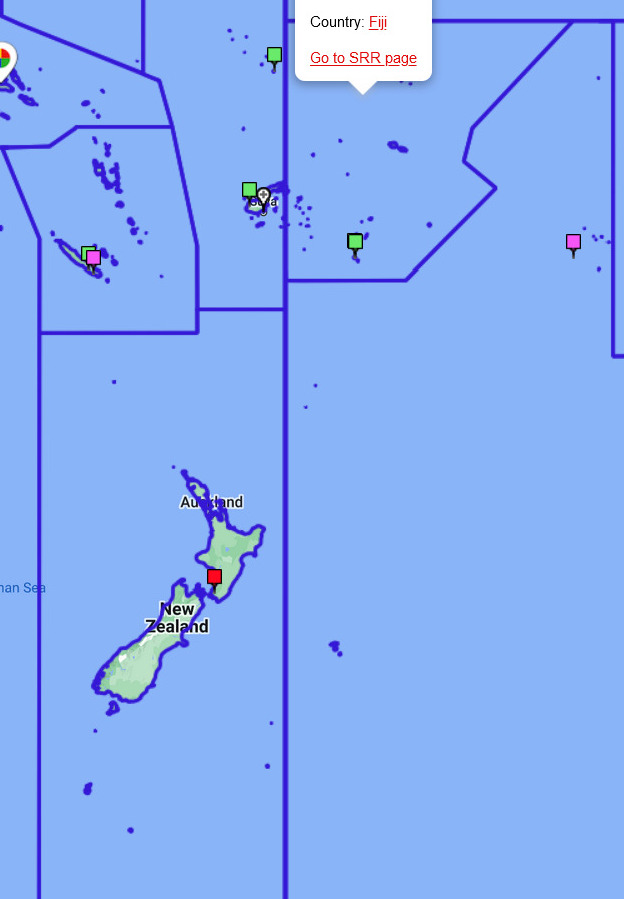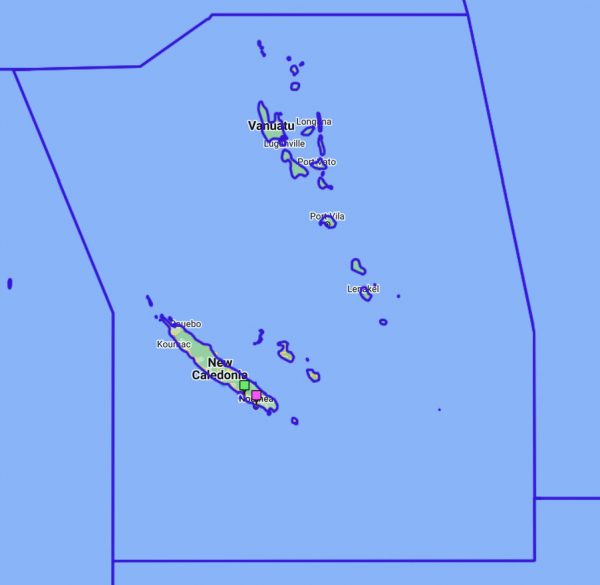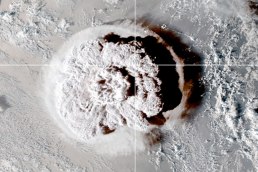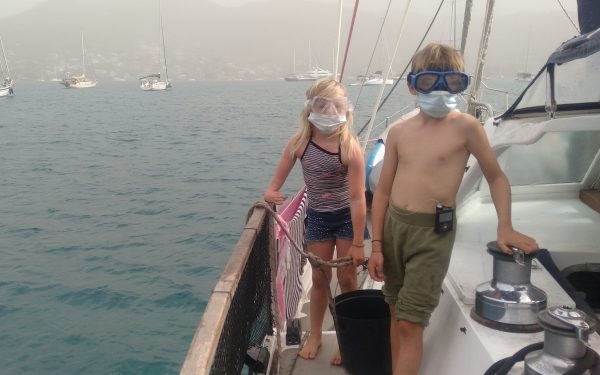EMERGENCY NUMBERS
PANAMA
SRR:
Tel: +507 316 0525
oficinasarelt@aeronautica.gob.pa
Telephone +507 316 0525
Alternate #'s +507 520 6299
Website http://www.aeronaval.gob.pa/
SRR:
Tel: +507 315 0472
oficinasarelt@aeronautica.gob.pa
Alternate #'s
+507 315 0541
+507 524 9438
+507 524 9439
Cell Phone: +507 699 70667
Email
oficinasarelt@aeronautica.gob.pa
COLOMBIA
Buenaventura Coast Guard Station
Tel: +57 (1) 3692000 ext 12704 / 120707
c3iegub@armada.mil.co
https://www.armada.mil.co
MRCC Pacífico SRR:
Tel: +57 315 731 7401 or +57 316 452 1124
copafnp@armada.mil.co
Telephone +57 315 731 7401 or +57 316 452 1124
Email
copafnp@armada.mil.co
ectmcp01@dimar.mil.co
ECUADOR
Tel: +593 4 2480812
Alternate:
+593-4-2321602
coguar@armada.mil.ec
Website https://www.coguar.dirnea.org
Tel: +593-4-2505302
guayaquil_radio@armada.mil.ec
Website http://www.dirnea.org
MEXICO
MRCC Mazatlan (Pacific Ocean)
Latitude, Longitude:
(23.23332977,-106.4000015)
Telephone:
+52 669 985 2411
Email: maritm@telecomm.net.mx
52 699 985 2428
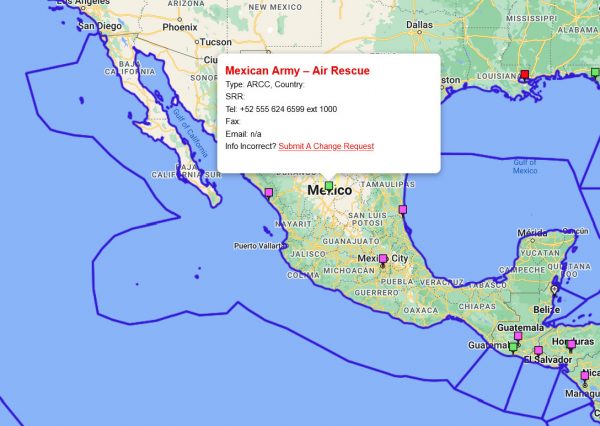
GUATEMALA
MRCC Pacific Naval Base
Latitude, Longitude:
(14.61833,-90.52500153)
Telephone:
+502 788 11056 Alternate: 11057
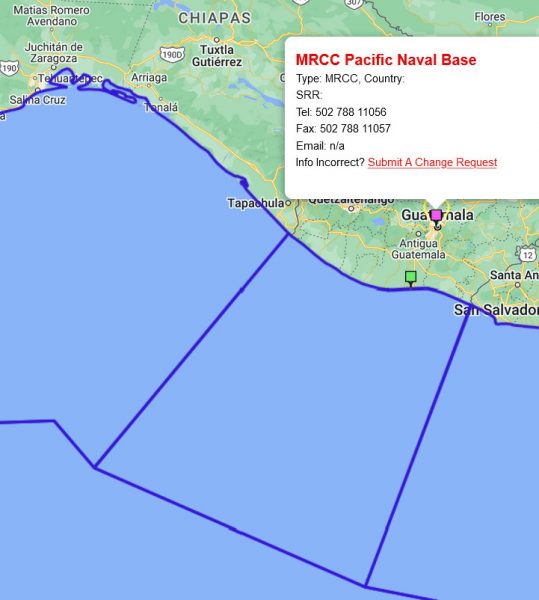
EL SALVADOR
MRCC Commander of the Navy San Salvador
Type: MRCC, Country: El Salvador, SRR: SRR EL SALVADOR
Latitude, Longitude:
(13.70166969,-89.19999695)
Telephone:
+503 276 2605 24 hours/day
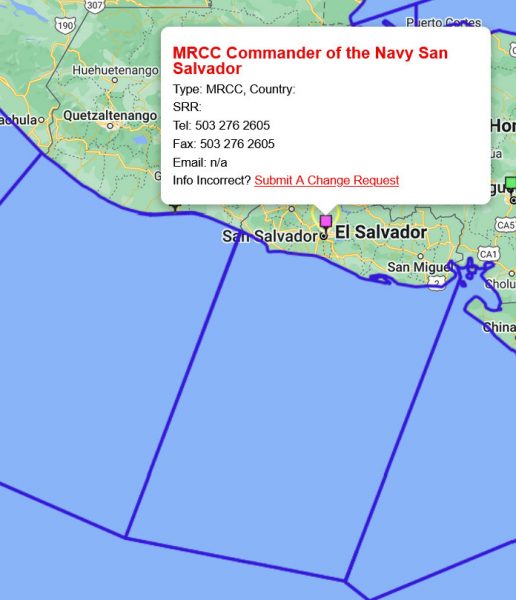
NICARAGUA
RCC Managua
Type: MRCC, Country: Nicaragua, SRR: SRR NICARAGUA PACIFIC COAST
Latitude, Longitude:
(12.15167046,-86.27333069)
Telephone:
+ 505 2331428
Email:
fzaaerea@tmx.com.ni
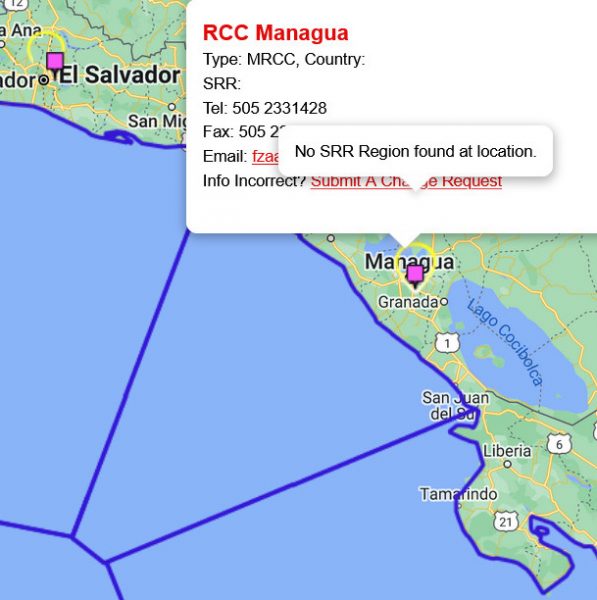
PERU
Type: MRCC,
Latitude, Longitude:
(-12.06667042,-77.15000153)
Telephone:
+51 1 420 2020
Email:
COMOPERGUARD.PEMCC@DICAPI.MIL.PE
ccomoperguard@gmail.com
Duty Operator
Peruvian Mission Control CenterCoastguard Operations CommandPeruvian NavyAtte.
Operador de Guardia.
Centro de Control de Misiones del Perú - PEMCC
Comandancia de Operaciones GuardacostasTelf. 00+51 1- 4291547Telf. 00+51 1- 4530599
Telf. 00+51 1 - 4202020
Fax. 00+51 1- 4291547
Cel. +51 913859448

CHILE
MRCC Iquique
Latitude, Longitude:
(-20.26000023,-69.91333008)
Telephone:
+56 57 2401945 Alternate numbers: +56 57 401986
Email:
mrcciquique@directemar.cl
MRCC Valparaiso
Latitude, Longitude:
(-33.0483284,-71.60166931)
Telephone:
+56-32-2208909 Alternates: +56-32-2208913
Email:
mrccvalparaiso@directemar.cl
MRCC Talcahuano
Latitude, Longitude:
(-36.68333054,-73.09999847)
Telephone:
56 41 2266162 Alternates: 56 41 2266196 / 2266186
Email:
mrcctalcahuano@directemar.cl
MRCC Puerto Montt
Latitude, Longitude:
(-41.46667099,-72.94999695)
Telephone:
56 65 561190 Alternates numbers:56-65-561153
Email:
mrccpuertomontt@directemar.cl
MRCC Punta Arenas
Latitude, Longitude:
(-53.15000153,-70.80000305)
Telephone:
56-61-2201161 Alternates: 56-61-2201140
Email:
mrccpuntaarenas@directemar.cl
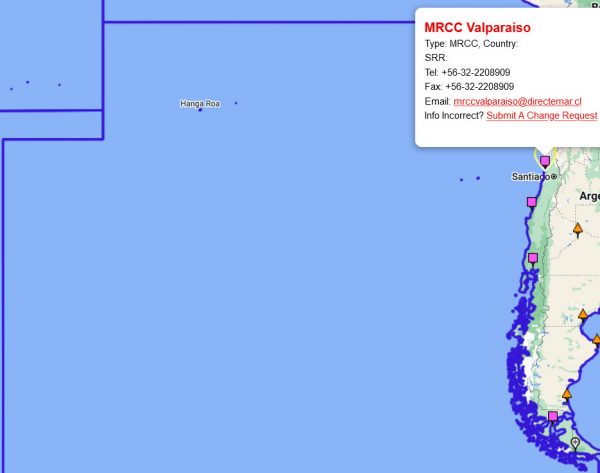
FRENCH POLYNESIA
SRR FRENCH POLYNESIA -
Organisme d’etudes et de coordination pour la recherche et le sauvetage en mer (SECMAR)
Tel: +33(0)1 42 84 16 06
COOK ISLANDS
RCC Rarotonga
SRR:
Tel: +682 224 99
TONGA
ARCC Fua’amotu International Airport
SRR TONGA
Telephone:
+676 35393
FIJI
SRR:
Tel: 679 3315 380
operations@mrscfiji.org
rccsuva@yahoo.com
MRCC Fiji
SRR:
Tel: +679 3316 204
RCC Fiji
SRR:
Tel: +679 3316205
operations@rccfiji.org
Telephone
+679 3316205
+679 3316204
+679 3316206
+67 93315803
SOLOMON ISLANDS
MRCC Honiara
SRR:Tel: +667 21609
mrcc@solomon.com.sb
Telephone +667 21609 +677 21535
NEW ZEALAND
JRCC NEW ZEALAND (RCCNZ)
Tel: +64 4 577 8030
rccnz@maritimenz.govt.nz
Telephone +64 4 577 8030
Taupo Maritime Radio (ZLM)
Tel: +64-4-550-5280
maritime@kordia.co.nz
Telephone +64-4-550-5280
NEW CALEDONIA & VANUATU
SRR:
Tel: +687 35 24 22
bria@aviation-civile.gouv.fr
MRCC Noumea
Tel: +687 291870
operations@mrcc.nc
Tel +687 292121
AUSTRALIA
JRCC Australia
Tel: Maritime SAR contact +61 2 6230 6811
rccaus@amsa.gov.au
SAR contact +61 2 6230 6899
SARSAT Alerts +61 2 6279 5774
Email rccaus@amsa.gov.au
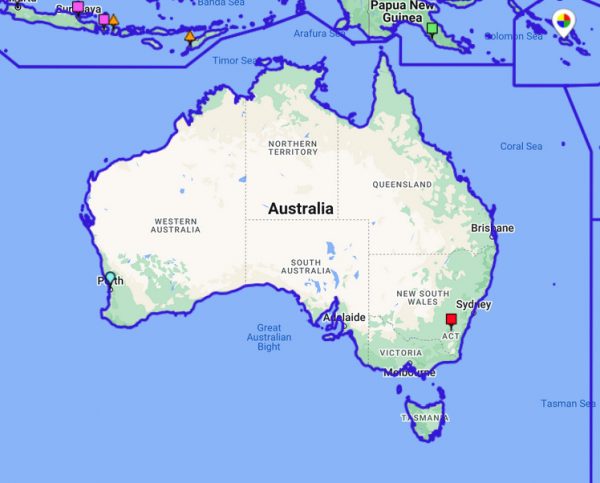
DANGERS 🌋💨 🌀 🌪️ 🏴☠️ ☣️🪸 ☢️ 📦 🌊
DANGERS 🌋💨 🌀 🌪️ 🏴☠️ ☣️🪸 ☢️ 📦 🌊
TSUNAMIS
TSUNAMIS
PRELIMINARY EARTHQUAKE PARAMETERS * MAGNITUDE 7.3
SAMPLE REPORT FROM UNESCO
---------------------------------
* ORIGIN TIME 1049 UTC NOV 11 2022
* COORDINATES 19.3 SOUTH 172.1 WEST
* DEPTH 58 KM / 36 MILES
* LOCATION TONGA REGION
EVALUATION
----------
* AN EARTHQUAKE WITH A PRELIMINARY MAGNITUDE OF 7.3 OCCURRED IN
THE TONGA ISLANDS REGION AT 1049 UTC ON FRIDAY NOVEMBER 11
2022.
* BASED ON ALL AVAILABLE DATA... THE TSUNAMI THREAT FROM THIS
EARTHQUAKE HAS NOW PASSED.
TSUNAMI THREAT FORECAST...UPDATED
---------------------------------
* THERE IS NO LONGER A TSUNAMI THREAT FROM THIS EARTHQUAKE.
RECOMMENDED ACTIONS
-------------------
* REMAIN OBSERVANT AND EXERCISE NORMAL CAUTION NEAR THE SEA.
OTHERWISE... NO ACTION IS REQUIRED.
POTENTIAL IMPACTS
-----------------
* MINOR SEA LEVEL FLUCTUATIONS MAY OCCUR IN SOME COASTAL AREAS
NEAR THE EARTHQUAKE OVER THE NEXT FEW HOURS.
PUMICE
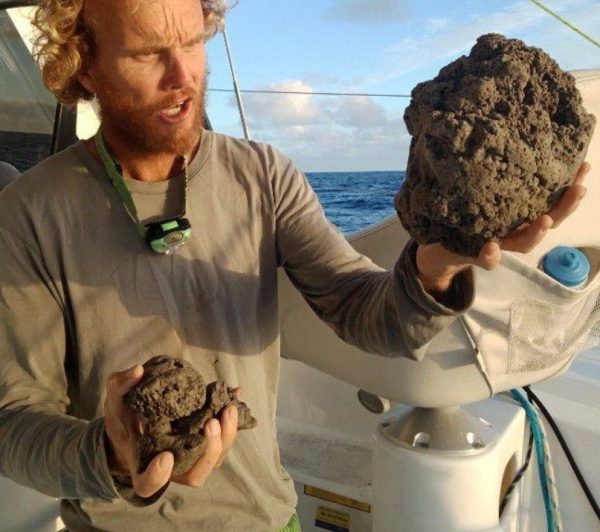
SAMPLE REPORT
Report of Volcanic Rubble Slick dangerous to vessels.
Catamaran ROAM sailing to Fiji encountered volcanic
rocks (Pumice) completely covering the ocean surface at location:
18 55' S
175 21' W
Time 0800hrs UTC (1900hrs local) 15/8/19.
Rubble slick made up of rocks from marble to
basketball size such that water was not visible.
Description of event:
We had heard the previous day on email of "pumice
fields" 50NM North of Vava'u. We saw none as we rounded North of Vava'u earlier
in the day on our route ex Bora Bora.
Sailing on 255T we started seeing some floating
rocks of random sizes (marbles to tennis balls) from position 18 46' S 174 55'W.
We reduced sail to slow our speed.
At position 18 50' S 175 05' W we had faint but
distinct smell of sulfur. TWD = 115T at the time had us down wind of Home Reef
charted as area of volcanic activity.
We continued sailing at reduced speed on 250T.
At position 18 54'S 175 19'W we started to see and
strike larger floating rocks. We took down all sail. Allowing the boat to
continue on bare poles at 2-3kts on COG 255T. As we could no longer smell the
sulfur we assumed we would be soon clear of the rubble so elected to continue at
slowest speed.
At approx 0700hrs UTC (1900 local) 15/8/19 at
position 18 55' S 175 21' W we entered a total rock rubble slick made up of
pumice stones from marble to basketball size. The waves were knocked back to
almost calm and the boat was slowed to 1kt. The rubble slick went as far as we
could see in the moonlight and with our spotlight. We made a turn to starboard
and managed to sail clear of the rubble slick under Staysail. We had entered it
approx 200m and the edge could be made out in the partial moonlight back to the
NE. It was extensive in all other directions.
In the slick our steering became
temporarily/partially fouled by rocks jamming between rudders and hull.
Our speed log was also inturupted but thankfully
this morning both functioning as normal.
Once clear of the rubble we acted with caution and
retraced our course under 3rd reef main and staysail before turning south and
then west.
Other vessels in the imidiate area were notified and
we remained in touch to update one another on our status and that of the
conditions in our area.
My intention was to return to the East and sail
around the windward side of Home Reef and surrounding charted areas of volcanic
activity some 35NM to our SE. The two other yachts I informed of the rubble
slick found clear water going South and turning west from 19 00' S 175 05' W so
we followed them.
We have since cleared all sign of volcanic rock and
continuing to Fiji
SEARCH AND RESCUE CENTERS SAR WORLDWIDE
SEARCH AND RESCUE CENTERS SAR WORLDWIDE
https://sarcontacts.info/
Search and Rescue (SAR)
When should I contact SAR
If you are in distress or need to report an emergency, do NOT send it via email, contact the Coast Guard via telephone or radio. The Global Maritime Distress and Safety System (GMDSS) provides a number of additional means for contacting or alerting SAR authorities.
Vessels an emergency and need of Coast Guard assistance should use: VHF-FM Channel 16 (156.8 MHz), dial 911.
SAR will respond immediately to your or a Mayday call, and may also notify state and local search and rescue units in your vicinity. The Coast Guard will also transmit an Urgent Marine Information Broadcast over marine-band VHF-FM radio Channel 16, notifying all vessels in the area of your emergency.
MAYDAY
Make a Mayday call if a vessel or person is in grave and imminent danger and immediate assistance is required. For lesser emergencies, a “Pan-Pan” or “Sécurité” may be appropriate.
• Check that your VHF radio is on and high power setting is selected:
Select Channel 16 (or 2182kHz for MF)
• Press the transmit button and say slowly and clearly:
“MAYDAY, MAYDAY, MAYDAY”
“THIS IS… ”
(say the name of your vessel 3 times. Say your MMSI number and call sign)
“MAYDAY, THIS IS…”
(say name of vessel)
“MY POSITION IS…”
(latitude and longitude, true bearing and distance from a known point, or general direction)
“I AM…”
(say nature of distress e.g., SINKING, ON FIRE)
“I REQUIRE IMMEDIATE ASSISTANCE”
“I HAVE…”
(say number of persons on board PLUS any other useful information – such as sinking, flares fired, abandoning to liferaft)
“OVER”
• Now release transmit button and listen for reply
• Keep listening to Channel 16 for instructions
• If you hear nothing then repeat the distress call
Vessels with GMDSS equipment should make a MAYDAY call by voice on Ch 16 or MF 2182 kHz after sending a DSC Distress alert on VHF Ch 70 or MF 2187.5 kHz
DSC Radio Emergency Procedure
• In an emergency, press the DSC radio’s red button for 15 seconds and then transmit a voice message on Channel 16.
• Prepare for sending/receiving subsequent distress traffic on the distress traffic frequency (2182 kHz on MF, Ch16 on VHF)
• NOTE: The nature of distress can be selected from the DSC radio receiver’s menu.
PAN-PAN
(pronounced pahn-pahn) used to signal urgent information, like when someone has fallen overboard, or a boat is drifting into shore or a busy shipping channel.
Organization and Management
○ SAR System Concept
○ Benefits of Services
○ Global, National, Regional Systems
○ Components of SAR System
○ SAR as a System
○ Rescue Co-ordination Center and Sub-Centers
○ Training, Qualification, & Certification of SAR Professionals
○ Building Professionals – Training, Qualification, Certification
○ Exercising Capability
○ SAR Communications
○ Basic Functions and Requirements
○ Co-ordination of components of the SAR System
○ SAR System Management & Organizational Improvement
○ Planning and Resource
○ Assessment, Analysis, and Implementation
○ DOTMLPF Analysis 2
SAR System Concept
○ Why Provide SAR?
○ Benefits of SAR Services
○ International SARAgencies
○ International SAR Documents
○ Global SAR Concept
○ National and Regional Systems
DUTY TO ASSIST
VESSELS AND AIRCRAFT HAVE A DUTY TO PROVIDE ASSISTANCE TO OTHER VESSELS, AIRCRAFT OR PERSONS IN DISTRESS WITHOUT REGARD TO LOCATION NATIONALITY OR CIRCUMSTANCES
Benefits of SAR Services
○ Reduction of loss of life and suffering
○ Safe/Secure environment for maritime related industries, commerce, recreation,
and travel
○ Resource for initial response during natural disasters as integrated into
national emergency management system
○ Positive publicity about responses to SAR events
○ Method of promoting co-operation between States
○ Legal basis – as a party to the International Convention for the Safety of
Life at Sea (SOLAS) – State provided SAR
International SAR Agencies
○ International Maritime Organization (IMO)
○ International Civil Aviation Organization (ICAO)
○ Focus on SAFETY
○ Develop global SAR plans, procedures, techniques and training for SAR
○ Both envision a “patchwork” of SAR Regions (SRRs) encompassing globe
with rescue coordination centers responsible for assigned SRRs
Basic SAR System Functions
○ Receive, acknowledge, and relay distress alerts
○ Coordinate SAR response
○ Conduct SAR operations
○ The SAR System cannot be organized and effective without management and support
SAR System Management & Support
○ SAR System Managers must understand…
○ the fundamentals of the system they are managing;
○ their own basic responsibilities and functions;
○ key types of SAR plans and planning processes; and
○ how to begin with available resources and economically improve the system
Basic Requirements
○ Basic requirements for developing an effective SAR
system include:
○ legislative establishment of the SAR services arrangements for use
of all available resources, and provision of others if necessary;
○ establishing geographic areas of responsibility with associated
RCCs and RSCs;
○ staffing, training, and other personnel support to manage and operate
the system;
○ adequate and functioning communications capabilities; and
○ agreements, plans and related documents, to achieve goals and define
working relationships.
Global SAR Concept
○ Eliminates the need for each State to provide SAR services for its
own citizens wherever they travel world-wide
○ The globe is divided into SRRs, each with associated SAR services
which assist anyone in distress within the SRR without regard to
nationality or circumstances
National and Regional Systems
○ A regional approach can reduce cost and improve distribution of distress alerts,
coverage and services.
○ States can sometimes support each other with SRUs to reduce the total number of
units needed for adequate coverage and readiness.
○ Establishment of national or regional SAR systems is typically basedon
development of multilateral national or regional plans, agreements, etc.
○ Usually provides for;
○ effective use of all available resources for SAR;
○ delineation of SRRs,
○ description of relationships between the parties
SAR and the 1949 Geneva Conventions and their Additional Protocols
○ ln times of armed conflict, SAR services will normally continue to be
provided in accordance with the Second Geneva Convention of 1949
○ The SAR services recognized by their Administrations are afforded
protection for their humanitarian missions
○ Coastal installations should, in time of armed conflict, display the distinctive
emblem (red cross or red crescent)
○ Parties to a conflict notify the other Parties with the name, description and
locations (or area of activity) of their above-mentioned rescue craft and coastal
installations in the area they are located
Communications
○ Good communications are essential
○ They should promptly provide the RCC with alerting information
permitting the RCC to dispatch SRUs and other resources to search
areas without delay and to maintain two way contact with the persons in
distress.
Main Functions SAR Communications
○ Receipt of alerts from equipment used by persons in distress
○ Exchange of information with persons in distress, and among the SAR
Mission Coordinator (SMC), OSC and SAR facilities for coordination of
responses to SAR incidents
○ Direction Finding (DF) and homing which allow SRUs to be dispatched to
the vicinity of the distress and to home on signals from equipment used by
survivors
Alerting Posts
○ Any facility involved in receiving information about an apparent distress situation and
relaying it to an RCC or RSC
○ They include facilities such as air traffic services (ATS) units or coast radio stations (CRSs)
○ Communications may or may not be the primary purpose for the alerting post, but post must
be able to forward the distress information to theRCC
○ The ability of an RCC to act quickly and effectively when an emergency occurs depends
largely on the information forwarded to it by alerting posts
Locating
○ Locating capabilities enable the responding SAR facilities to minimize the search
time and to get to the actual position of distress for rescue
○ Most civil aircraft operating over ocean areas and remote land areas, and many
other aircraft, are required to carry an Emergency Locator Transmitter (ELT)
○ Ships and some other craft are required to carry emergency position-
indicating radio beacons (EPIRBs) capable of transmitting signals.
○ Having a very precise search object position is useful but does not eliminate
the need for SRU homing capabilities
SAR Coordination
○ Communications among SAR facilities will depend on local agreements and
the organization of the SAR services in the SRR and on the equipment
available
○ RCCs normally assign a SAR Mission Coordinator (SMC) to
handle a SAR incident
○ Communications to and from RCCs and RSCs should be as timely and
reliable as possible and sufficient to handle the total diversity and volume
of needs for the worst potential scenarios
Rescue Coordination Center (RCC)
○ The RCC is an operational facility responsible for promoting efficient
organization of SAR services and for coordinating the conduct of SAR
operations within an SRR
○ SAR managers should ensure that the RCC is familiar with the
capabilities of all of the facilities available for SAR in its SRR
Joint Search and Rescue Centers (JSRC)
○ Can be established at minimal cost by combining aeronautical and maritime RCCs
○ Staffing would be determined by the responsible agencies and could include “joint” staffing by more than one agency
○ Benefits in fewer facilities to establish or maintain
○ Reduced cost
○ Less complexity for alerting posts in forwarding distress alerts
○ Better coordination and sharing
○ A coastal State may have a MRCC but not be able to be provided with anARCC
○ Properly established, the JRCC may improve SAR service
performance in most areas
Purpose and Requirements
○ ICAO’s Annex 12 and the International Convention on Maritime Search and Rescue require that SAR providers establish an RCC for each SRR.
○ The RCC must have certain basic capabilities before it is recognized as having responsibility for an SRR.
RCC Required Capability
○ 24-hour availability trained persons
○ Persons with a working knowledge of the English language
○ Charts which apply to the SRR:
○ Aeronautical, nautical, topographic andhydrographic
○ Means of plotting
○ Ability to receive distress alerts
○ Immediate communications with associated:
○ ATS units and RSCs
○ DF and position-fixing stations associated CRSs
○ Rapid and reliable communications with:
○ Parent agencies of SRUs and RCCs
○ Designated meteorological offices
○ Employed SRUs
○ Alerting posts
○ Plans of operation
○ Ability to coordinate medial advice and assistance
RCC Desired Capability
○ Wall chart depicting SRR, SRSs, and neighboring SRRs, and SAR resources
○ Computer resources
○ Databases
○ Vessel tracking information / systems
Facilities and Equipment
Communications
○ An RCC should be located where it can effectively perform its functions within its SRR
○ Communications needs can sometimes be met by ATS channels, public services,
or installation of an lNMARSAT earth station
○ Reliable dedicated lines which can preserve message priority are preferred
○ One telephone line should have an unlisted, confidential number to ensure the
availability of one out-going line in situations where there are many incoming telephone
calls
○ All voice equipment, including telephones, should be attached to a multichannel
tape recorder, preferably with a time recording
Facilities and Equipment
Information
○ Ready access to operational information will help the SMC take immediate and
appropriate action in an emergency
○ Much of this information derives from the RCC plan of operations and SAR databases
○ Use of large-scale wall charts showing assigned SRRs and locations of
resources
○ SAR facility status board or computer file reflecting the current status of all SAR
facilities telephone numbers, and other useful information, is practical
○ The chart or map should also show areas adjacent to the SRR.
○ The map could display, by means of colored pins or other symbols, information of interest.
Facilities and Equipment
Plotting Facilities
○ The RCC and RSC should have a stock of maritime and aeronautical maps and charts, plotting equipment,
and other information necessary for their use.
Publications and supplies
○ The publications and supplies to be available at the RCC shouldinclude:
○ SAR publications of ICAO, IMO, the national and neighboring SARauthorities;
○ relevant State documents, e.g., Air Navigation Regulations and Notices toMariners and, if considered necessary, those of
adjacent States;
○ communications publications;
○ aeronautical information publications (AIPs);
○ indexes of names, addresses, telephone and facsimile numbers; and
○ relevant checklists and forms
Staffing
○ RCC Chief
○ RCC chief may be a person who also performs other functions
○ Must make appropriate preparations, plans, and arrangements
○ Ensure that when an incident occurs the SAR operation can be performed.
○ RCC Staff
○ The RCC staff consists of personnel who are trained and capable of planning and coordinating SAR
operations.
○ If the RCC staff has duties besides SAR, the additional functions should be considered when
determining the staffing needs.
○ Number of personnel required will vary with local requirements, traffic density,
seasonal conditions, meteorological conditions and other SRRconditions.
○ An RCC must be in a constant state of operational readiness.
○ Where the RCC does not maintain continuous staffing, or only has one trained and capable RCC
person on duty, provision must be made forstand- by RCC staff to be mobilized rapidly.
SAR Mission Coordinator (SMC)
○ A SMC should be designated for each specific SAR operation, and adequate numbers of
personnel qualified to perform the SMC function must be readily available on a 24 hour basis.
○ This is a temporary function which may be performed by the RCC chief or a designated SAR
duty officer
○ SMC is in charge of a SAR operation until a rescue has been effected or untilit has become
apparent that further efforts would be of no avail.
○ SMC is responsible for planning the search and coordinating the transitof SRUs to the scene.
○ The number of persons to be available for assignment as SMC will dependon:
○ possible need to coordinate operations from a location other than the RCC, e.g.,
from available communications facilities;
○ expected frequency of SAR incidents, including the possibility of more thanone incident occurring
simultaneously
○ size of the area and prevailing conditions (e.g., climate or topography)
○ need to allow for vacation, training courses, illness, relief and travel
Training, Qualification, Certification
○ RCC chiefs, SMCs, and RCC staff need specific training in watch standing,
coordination of assorted resources, search planning, and rescue planning.
○ SAR Managers have the responsibility to ensure that the overall training program is
effective and ensure that all SAR service personnel reach and maintain the
required level of competence.
○ Qualification and Certification processes are used to ensure that sufficient
experience, maturity and judgement are gained.
○ The individual must, by demonstration of abilities, show mental and
physical competence to perform as part of a team.
○ Certification is official recognition by the organization that it trusts the individual
to use those abilities.
Plans of Operation
○ Each RCC and RSC should develop plans that:
○ Meet the requirements of applicable international SAR
manuals
○ Cover all the emergency scenarios likely to occur within the
SRR
○ Are reviewed and updated regularly
○ Are in a convenient form for quick and easy use
Rescue Sub Centers
○ There may be situations where an RCC is not able to exercise direct
and effective control over SAR facilities in an area within its SRR.
The establishment of an RSC with its SRS may be appropriate.
Examples of such situations include:
○ Where the communications facilities in a portion of an SRR are not adequate
for close co-ordination between the RCC and SAR facilities;
○ Where the SRR encompasses a number of States or territorial divisions of a
State in which, for political or administrative reasons, local facilities can only be
directed and controlled through designated local authorities
○ Where local control of SAR operations will be more effective
SAR Facilities
○ SAR facilities include designated SRUs and other resources which can be
used to conduct or support SAR operations.
○ Facilities selected as SRUs should be able to reach the scene of distress
quickly and, in particular, be suitable for one or more of the following
operations:
○ providing assistance to prevent or reduce the severity of accidents andthe hardship of
survivors, such as escorting an aircraft,
○ standing by a sinking vessel;
○ conducting a search;
○ delivering supplies and survival equipment to the scene;
○ rescuing survivors
○ providing food, medical or other initial needs of survivors; and
○ delivering the survivors to a place of safety.
Equipment Needed By SRU
○ Communications
○ Mobility
○ Supplies and Survival Equipment
○ Other required equipment as determined
Search and Rescue Unit
○ Designated SRU
○ SRUs need not be dedicated solely to SAR operations, but should have the
training and equipment necessary for proficient operations.
○ Specialized SAR Units
○ Specialized SRUs are teams with specialized training and equipment created
for specific rescue scenarios; such as mountain or desert rescue
Search and Rescue Unit
○ Other SAR Facilities
○ Existing facilities often may be suitable for SAR operations with minimal modifications,
added equipment or additional crew training.
○ Examples include: teaching look-out scanning techniques to volunteers and auxiliary
organizations; installing radiotelephone equipment on fishing vessels, yachts and other
small craft; and using isolated stations as alerting posts. By providing training, installing
some low-cost equipment and integrating all facilities into the SAR system
○ Medical Advice andAssistance
○ Maritime telemedical assistance service (TMAS)
On Scene Coordinator (OSC)
○ When two or more SAR facilities are working together on the same
mission, it is usually advantageous if one person is assigned to co-ordinate
the activities of all participating facilities.
○ The SMC designates this OSC, who may be the person in charge of an
SRU, ship, or aircraft participating in a search, or someone at another
nearby facility able to handle OSC duties.
○ Usually the first to arrive on scene
○ May perform duties as the SMC
Support Facilities
○ Support facilities enable the operational response resources
(e.g., the RCC and SRUs) to provide the SAR services.
○ There is a wide range of support facilities and services, which
include the following:
○ Training facilities Facility maintenance
○ Communications facilities Management functions
○ Navigation systems Research and development
○ SAR data providers (SDPs) Planning
○ Medical assistance Exercises
○ Aircraft landing fields Refuelling services
Voluntary services (e.g., Red Cross) Critical incident stress counsellors
Training should include at least the following topics
○ Aeronautical drift
○ AFN (Aeronautical Fixed Network)
○ AFTN (Aeronautical Fixed Telecom Network)
○ Bailout scenarios and planning
○ Briefing/questioning SRUs
○ Case studies
○ Charts
○ Coastal SAR planning
○ Computer applications
○ Cospas—Sarsat
○ Datum marker buoys
○ Datum determination
○ Dealing with public and news media
○ Dealing with families
○ Documentation of incidents
○ Electronic sweep width
○ Emergency care
○ Environmental factors
○ Evaluation of flare sightings
○ Fatigue factors
○ Inmarsat
○ International aspects
○ Interviewing techniques
○ Leeway drift
○ Legal concerns
○ Look-out skills and limitations
○ Maneuvering boards
○ Medical advice
○ Obtain and evaluate data
○ On-scene coordinator duties
○ Parachute drift
○ Plotting skills
○ Registration databases
○ Rescue procedures
○ Resource allocation
○ Risk assessment
○ SAR agreements
○ SAR communications
○ SAR mission co-ordination
○ SAR operations conclusion
○ SAR phases, stages, and components
○ SAR resource capabilities
○ SAR system organization
○ SAR technology
○ Search areas
○ Search patterns
○ Search planning
○ Ship reporting systems for SAR
○ SRU selection
○ Stress management
○ Survival equipment
○ Vessel Tracking system
○ Visual sweep width
○ Water currents
Available Technology
○ Mobile Communications Equipment
○ Emergency Distress Comm Devices
○ Emergency Locator Transmitter (ETL) – 121.5 MHz
○ Emergency Position-Indicating Radio Beacons (EPIRB)
○ Personal Locator Beacons (PLB) – 406 MHz
○ Global Positioning System (GPS)
○ GADSS
○ Space Based ADS-B
Available Technology
○ SRU Comms Equipment
○ Direction Finding (DF) capability
○ Line od Position (LOP)
Available Technology
○ Land-Based Infrastructure
○ Alerting Post
○ SAR Communications Network
○ SAR Data Providers
○ GMDSS Master Plan
○ Ship Reports for SAR
○ Supplemental Capabilities
○ Instant-replay Recording Equipment
○ Caller Identification
○ MEDICO communications
○ Social media
ICAO’s Global Aeronautical Distress and Safety System (GADSS)
AIRCRAFT TRACKING
AUTONOMUS DISTRESS TRACKING
AUTONOMUS TRANSMISSION EVERY MINUTE
LOCALIZE SITE WITHIN 6 NM
5 SECOND LATENCY
Four stages of escalation:
• Normal Operation
• Abnormal Operation
• Distress Tracking
• Response & Recovery
SAR Communications
○ Maintain a continuous watch on the following international frequencies, if equipped to do so:
○ 2,182 kHz (radiotelephony)
○ 156.8 MHz FM (channel 16, radiotelephony) for vessel distress
○ 121.5 MHz AM (radiotelephony) for AC distress or beacon distresssignals
○ SOLAS communications equipment is referred to as Global Maritime Distress and
Safety System (GMDSS) equipment:
○ Inmarsat ship earth stations
○ VHF, MF, and HF digital selective calling (DSC) radios
○ maritime safety information receivers like NAVTEX and SafetyNET
○ hand-held VHF equipment
○ emergency position-indicating radio beacons (EPIRBs, ELT, PLB 406 MHz)
○ search and rescue radar transponders (SARTs)
○ AIS search and rescue transmitters (AIS-SARTs)
SAR Communications
○ Maintain a continuous watch on the following international frequencies, if equipped to do so:
○ 2,182 kHz (radiotelephony)
○ 156.8 MHz FM (channel 16, radiotelephony) for vessel distress
○ 121.5 MHz AM (radiotelephony) for AC distress or beacon distresssignals
○ SOLAS communications equipment is referred to as Global Maritime Distress and Safety System (GMDSS) equipment:
○ Inmarsat ship earth stations
○ VHF, MF, and HF digital selective calling (DSC) radios
○ maritime safety information receivers like NAVTEX and SafetyNET
○ hand-held VHF equipment
○ emergency position-indicating radio beacons (EPIRBs, ELT, PLB 406 MHz)
○ search and rescue radar transponders (SARTs)
○ AIS search and rescue transmitters (AIS-SARTs).
SAR Organization
○ SAR Coordinator (SC)
○ SAR Mission Coordinator (SMC)
○ Rescue Coordination Center (RCC)
○ Rescue Sub-Center (RSC)
○ On Scene Coordinator (OSC)
○ SAR Units (SRUs)
SAR Organization
○ SAR Coordinators are executive-level leaders and managers
○ SAR Coordinator is the person or agency with overall responsibility for establishing and providing civil SAR
○ Establishing, staffing, equipping and managing the SAR system
○ Providing appropriate legal and funding support
○ Establishing RCCs and RSCs;
○ Providing or arranging for SAR facilities and SAR resources;
○ Coordinating SAR training and exercises; and,
○ Promulgating SAR policies and supporting documents
Rescue Coordination Centre (RCC)
○ A unit responsible for promoting efficient organization of search and rescue services and for coordinating the conduct of search and rescue operations within a search and rescue region
Search and Rescue Mission Coordinator (SMC)
○ Designated person for duration of a SAR incident, usually in an RCC who is well trained and thoroughly familiar with SAR plans
○ Manages/Guides a SAR operation until completion
○ Gather information about the distress situations
○ Develop accurate and workable SAR action plans
○ Dispatch and coordinate the resources to carry out SAR missions
○ SMC Duties
○ Obtain and evaluate all data on the emergency
○ Ascertain the type of emergency equipment involved in incident
○ Knowledgeable of prevailing environmental conditions
SAR Organization
○ SMC Duties continued…
○ Ascertain locations of vessels and alert shipping
○ Plot the areas to search and decide method and assets to be used
○ Develop Search Action Plan and Rescue Plan
○ Coordinate with other RCCs
○ Review all reports and Modify plans
○ Arrange logistical support for Search effort i.e. Fuel, food, lodging…
○ Arrange logistical support for survivors
○ Issue reports
○ Determine when to suspend or terminate
○ Release of search assets
○ Notify accident investigators
○ Notify the State of registry
○ Prepare and disseminate final report
On-Scene Coordinator (OSC)
○ When two or more SAR facilities are working together on the same mission, one
person on scene may be needed to coordinate the activities of all participating
facilities.
○ SMC designates an OSC, who may be the person in charge of a:
○ Search and Rescue unit (SRU), ship, or aircraft participating in a search,
or…
○ Nearby facility in a position to handle OSC duties
○ The person in charge of the first facility to arrive at the scene will normally assume
the OSC function until the SMC arranges for that person to be relieved
SAR Units
○ A unit subordinate to a Rescue Coordination Center
○ Composed of trained personnel
○ Provided with equipment & material suitable for expeditious conduct of search &
rescue operations

